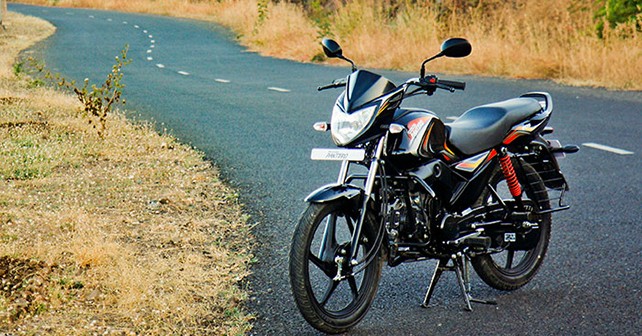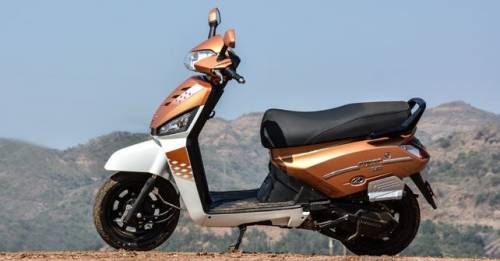
Mahindra’s first attempt at hitting the lucrative, and competent, motorcycle market went terribly wrong with the Stalio. The Mahindra Pantero is quite like the Stalio, except, it isn’t. It’s actually surprisingly good!
A band of boys – not the pop artist kind – but more real world, everyday chaps, wearing their suits and looking at each other through the tints in front of their eyes – only here, the chaps in question were downright playful blokes from the equally playful fraternity of motoring scribes. So, you can imagine that the clothing was a colourful spread of riding jackets, gloves and boots, and the tints in front of the eyes came courtesy of the flashy helmets we all love to flash to the average commuter on the road – makes us pamper our male egos, you see.
It was a silly game. Jamshed of Auto India, Kartik of TopGear India, Kyle of Motoring, Rahul of AutoBild India, and I lined up just at the edge of a very flowing curve – the sight ahead was a nicely laid out piece of blacktop. Just that it was uphill, and the plan involved, funnily enough, a drag race somewhere in the middle of it. It was bound to go all wrong.
Think of it – with our biking talent, we were hardly examples of skeletons-hanging-in-the-closet boy-racers who possess God-like talent of making mincemeat of time charts. Yet, here we were – all grown up, generously proportioned chaps, staring down at each other through the tinted visors of our helmets and making the (puny) engines of our respective bikes rev unnecessarily hard. And then the biker boy of Overdrive, Abhay, runs up to start the countdown. Wrists twisting the throttle, torso crouched to the max, such that our pot bellies would allow, we let go of the clutch the moment Abhay drops the flag. Animated faces behind the visors, various abuses, pointless throaty noises, and absolute to-the-limit stuff from each one makes for a laughable capture for all the guys with cameras in their hands. I won it – both times. My face is smug, as I type this. It was a silly game that made us become 4-year-old kids again. We loved every moment of it!
But behind all the fun-and-games, there was a basic learning – the Mahindra Pantero is leagues ahead of the erstwhile Stalio. It’s never happened that I rode a bike once and didn’t ask for it again – even if it was only to get a feel for it or to understand it better. I even rode the iniquitous Bajaj BYK a few times. This was the biggest motoring sin I ever committed. The Stalio changed that – the one time I rode it was all the riding that I ever did on that motorcycle. It was, quite plainly, absolutely terrible. The engine felt as strong as the military of Costa Rica and spending time on it was more like being inside a blender. The gearbox needed a hammer to operate. And riding with a hammer attached to one’s foot can be quite taxing, so you even had to invent new ways of riding. The quality was appalling, and it never really felt like a cohesive product.
Mahindra did the wise thing – scrapped the project, and started working on things afresh. R&D is crucial to any product development, and when you compare the Mahindra Pantero against the Stalio, it gives an impression that Mahindra might have rushed things with the Stalio in a desperate bid to enter the biggest segment of the motorcycle market in India. Now, with the Stalio a thing of the past, Mahindra has focused strongly on making the bike better in every way imaginable – so much so that the underpinnings of the Mahindra Pantero are almost completely different from the bike it replaces, the Stalio.
True, it doesn’t quite look that different because Mahindra has picked up the body panels of the Stalio and stuck them on a new frame, but then almost every other motorcycle in the 100cc segment looks rather tame and even – if I dare say so – quite uninspiring. However, the Pantero, quite surprisingly, comes across as an adequately impressive motorcycle. The first thing you notice is how much work has gone into this engine. This is a properly redesigned motor, and the internal parts have undergone a sea change – even the piston design was changed. The 8.4bhp that this 106.7cc sloper engine develops comes at a high-ish 7,500rpm that helps it go quite well (for its segment) when you’re hard on throttle. The engine comes with something called MCI-5 (Micro Chip ignited 5 curve) technology, which helps it deliver more torque at lower rpms, but I’d like the 8.5Nm of torque to have a bit more linear spread across the rev band. Having said that, the bike we had for our Mahindra Pantero did have a very strong mid-range – but the power did flatten out once we approached the higher revs.
However, a typical commuter motorcycle isn’t much about fun or the orgasmic experience from its engine – it’s more about its ability to go from point A to point B with ease, and the Mahindra Pantero does that beautifully. The seat is massive and cushions you in all the right places, and I reckon that doing long hours in the saddle wouldn’t be a thing to bother about. What I also liked was the way this bike maneuvers around bends. The neutral handling, aided by the double-cradle frame allows for the bike to be extremely flickable, and the three-point mounting of the engine reduces the vibrations to a great degree. The gearbox, too, was almost effortless. This 4-speed affair was actually the best bit for me on this bike – a huge improvement over the Stalio. Though still not as slick as what you get on, say, a Suzuki, but it’s still quite good and shifts through cogs in a very progressive manner. The ride quality was always a strong point with the Stalio, and it continues on the Mahindra Pantero. The suspension setup of the bike we had for our Mahindra Pantero was near ideal for Indian riding conditions, and the Mahindra Pantero rode over bumps and potholes without breaking a sweat.
The one department that Mahindra should still look into, though, is braking. The 130mm drums on both the ends aren’t adequate. The bite from the rear is still quite acceptable, but the front has no idea what pressing the lever means. There’s no sense of speed reduction when you apply only the front brake, and it also shows signs of fading under continued application.
In the end of our Mahindra Pantero, we would like to say that the Mahindra Pantero is a very good effort – it’s got a brilliant seat, and the ride quality is up there with the best. The improvements are very noticeable and the extensive R&D done by Mahindra has allowed them to introduce a very competent product in the market. The LED pilot and tail lamps, and a fully digital instrument cluster mean that it has some unique points of marketability. But with Honda and Hero being the segment leaders, Mahindra will have to really slug it out. And the battle is already quite intense, mind you.



























Write your Comment